I’ve been reworking a planting scheme for a commercial project that I want to share with you. It is a huge area (as in multiple city blocks long). My team and I have been managing these beds for years, so we have a good idea of what will work and what won’t. Currently, we have some perennial plants installed (along with a few shrubs here and there), but a lot of the planting is replaced seasonally at a huge labor and materials cost (not to mention the unsustainability of it all!). Both my client and I want to install something that will be more cost-effective and better for the environment.
The Three Main Goals of this Planting Design
Goal #1 – Use what is already on site
1) Use what we can of what is already there. The beds currently get a full treatment of annuals for the summer and the fall. These have historically been mixed with perennial hostas and astilbe that have been happy in the deep shade (both of which are now that are established throughout). Every fall, we remove the summer annuals and replace them with mums. It is typical in New England for property managers to plan for three seasons of plantings (spring, summer, and fall), but it is expensive! So, for this project, we are trying to re-think and eliminate the fall planting and some of the cycles of waste.
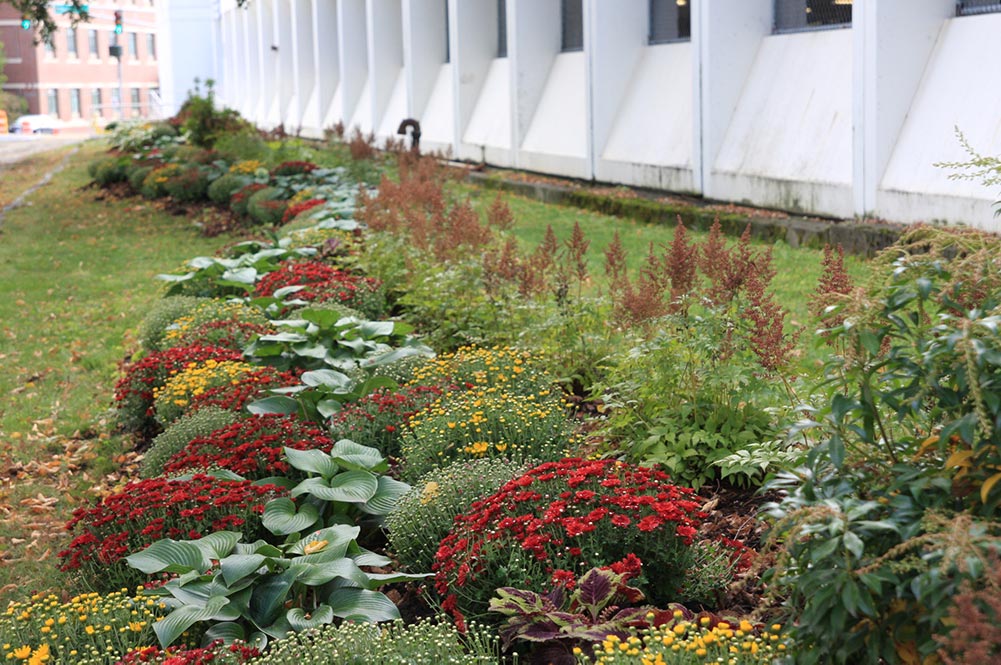
Look Good No Matter What
2) Look good despite the very difficult location. This garden is located in a busy urban area between a multistory parking garage and a busy city street and sidewalk. We deal with a lot of typical urban garden challenges (drug debris in the plantings, designs occasionally annihilated by errant cars and accidents, some vandalism, people who think plants like this are there for them to steal from, urination issues, etc etc). The plants need to be TOUGH. These sorts of north-facing shady areas are always a challenge to keep beautiful (it is so much easier to plan something exciting in full sun). But do not worry- there are plenty of great options, as you will see – read on).
At Least Three Seasons of Interest
3) Three-season Interest – The garden needs to look great from early spring through late summer with no downtime. This is right in the heart of the city and belongs to a property developer who is constantly in negotiations with the city and neighborhood.
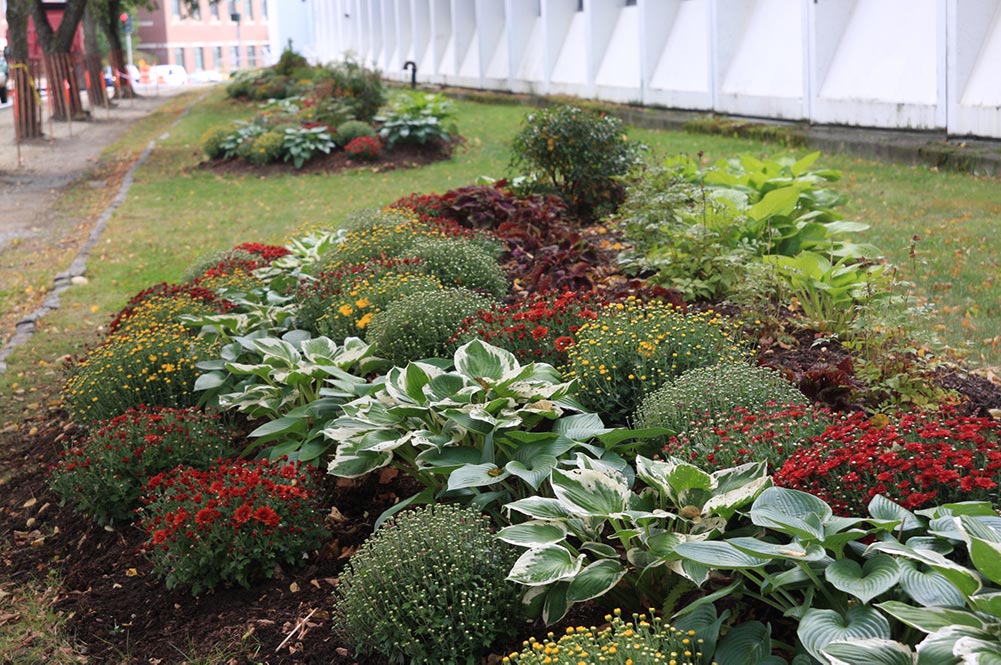
Our job is to help them be good neighbors and demonstrate that they are a positive force in the city. Much of this client’s site is an urban redevelopment project, and it will be for many years to come. Construction and renovation aren’t particularly nice to look at – so this is an attempt to put the nicest shade of lipstick on a pig.
Currently, we do swapouts of annuals in the late spring, early summer, and early fall. While that schedule works – we need the growing season to be attractive – but with little maintenance (compared to what we do now). We will continue to add colorful flowers to catch the eye of the local foot traffic and basically distract from the general ugliness of the rusty old car park backdrop – but it will be a fraction of what we do now.
The Existing Conditions
The setting is New England – USDA hardiness zones 5/6. The planting area is large – some of it is in full shade – and some is in partial shade. The overall goal is to reduce the need to plant so many annuals. But we still want to have a nice textural palette of plants that will be a great backdrop to the fewer seasonal plantings that we will do (after the renovation of these beds). This is really about cost savings – fewer annuals, more tough, low-maintenance perennials, and less work overall.
The area has well-drained soil that isn’t the best. The poor soil is primarily caused by a huge amount of mulch that has been layered endlessly by enthusiastic landscapers who came before us. These beds also get road spray, salts, and sand mixed in during the winter months.
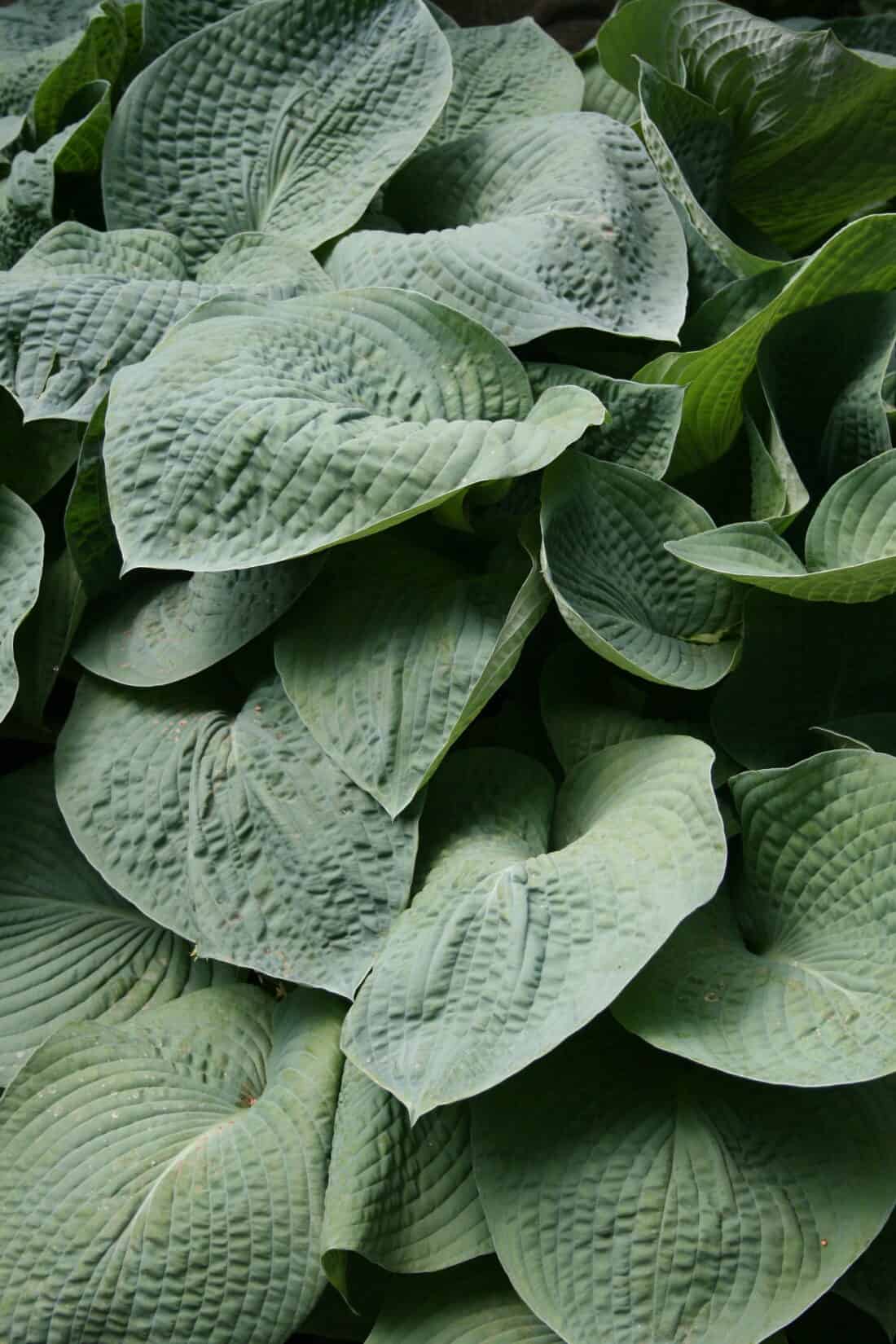
Blue Hosta
Image By Sarah Sphar
Red Astilbe
Red astilbe already exists onsite and throughout the beds. – image by Mark Levisay
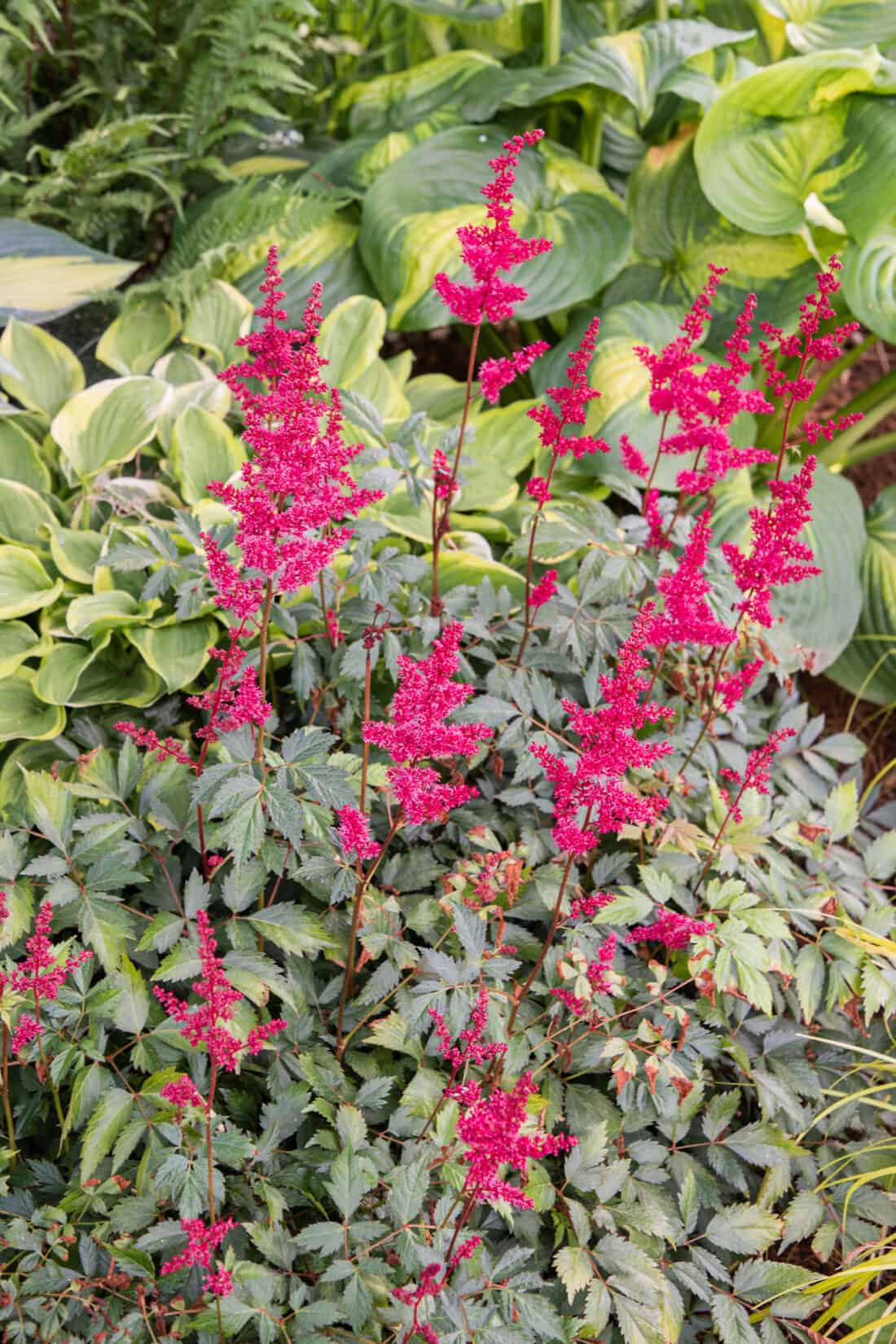
All our choices have to consider one other big factor – snow removal. These beds are adjacent to a parking garage. The property owner saves costs by scraping snow off the top and letting it fall to the ground below rather than trucking it down and out of the garage. So, we are removing all the shrubs and plants that can get crushed in lieu of herbaceous perennials only.
Here is our planting design proposal:
Existing Plants
1) Blue and Variegated Hosta: The attractive foliage of hostas are always a great contrast to the majority of other plants, whose leaves are inevitably smaller or of a different texture. This will always be a resting point for your eye in the scheme of the planting, because a hosta’s striking blue-green foliage adds a cool and calming element to garden landscapes. Hostas thrive in shaded areas and are prized for their low-maintenance and hardy nature. (We have Hosta ‘Francee’ and ‘Blue Cadet’ in this scheme as well as a unknown variegated variety)
2) Red astilbe – Red astilbe is valued for its vibrant red plumes that bring a bold burst of color to shaded gardens. This perennial is a hardy, low-maintenance choice, ideal for enhancing garden borders and woodland settings. (Astilbe chinensis ‘Vision in Red’ is already on site)
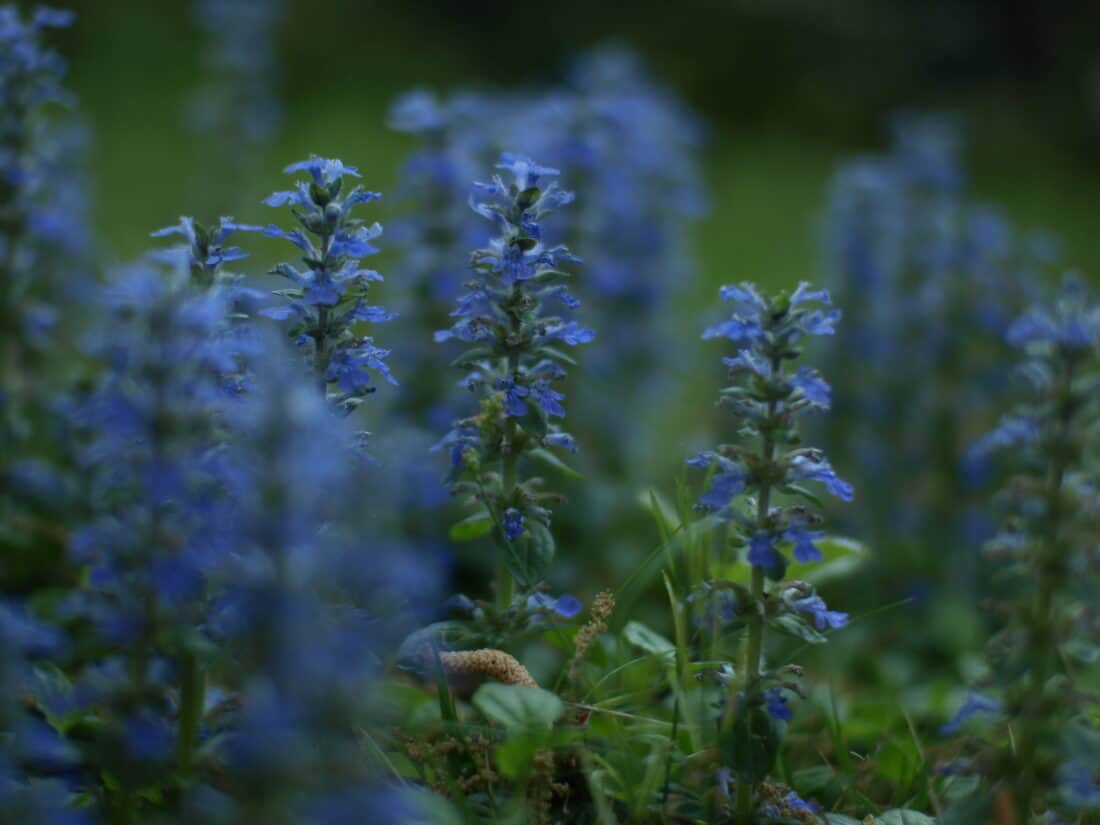
Proposed plants – Ground cover for the planting edges
1) Ajuga reptans
Ajuga reptans, often referred to as Bugleweed, features dense ground-hugging foliage and vibrant blue-purple flowers. This versatile ground cover is a low-maintenance, spreading perennial that thrives in shaded areas.
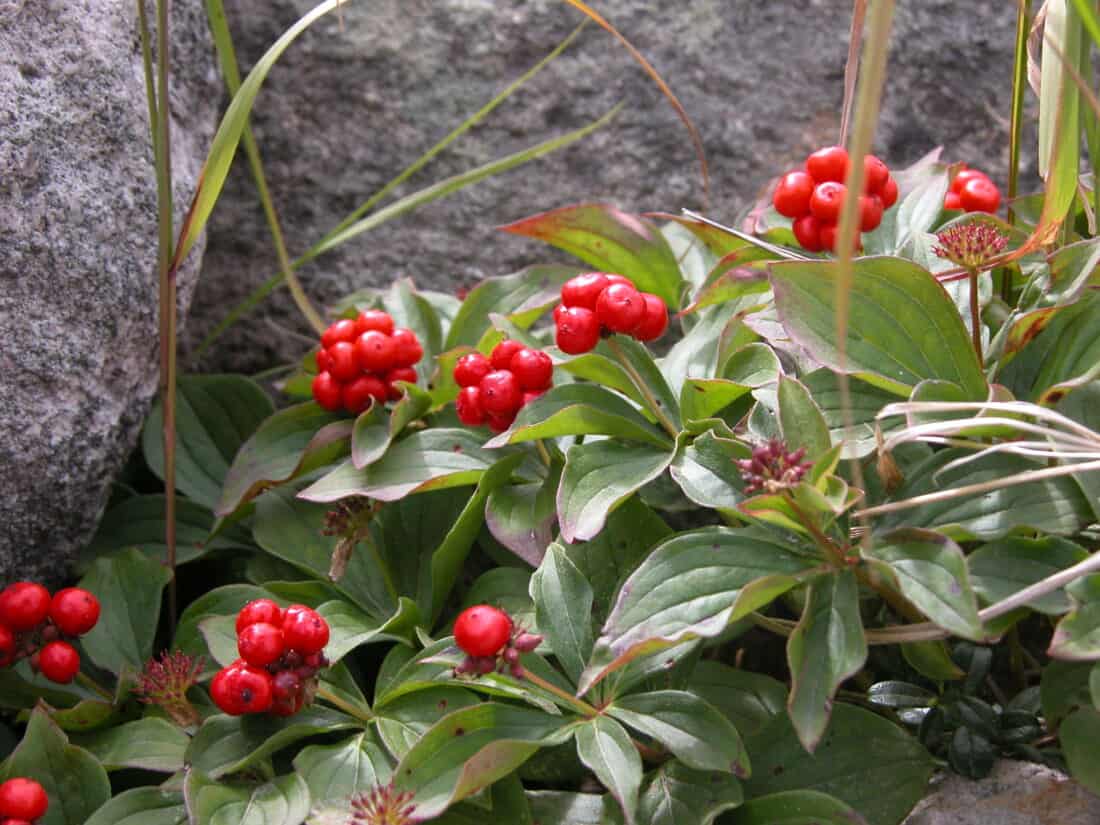
Shade loving Groundcover Alternatives:
If Ajuga is not preferred by the client, we will suggest a swap for Canadian wild ginger or Cornus canadensis- (bunchberry) – both are native groundcover in our area, but neither comes in the variety of colors that Ajuga can (from dark leave to variegated pink).
Asarum canadense (Canadian wild ginger) does not have a showy flower, and the foliage is pretty in woodland areas, but it is not as eye-catching for a scheme like this. The Cornus canadensis is beautiful with four-leaf star-shaped flowers and clusters of bright red berries, but it is expensive (3-4 times more than other options), and we have had a hard time getting it to establish quickly in other sites.
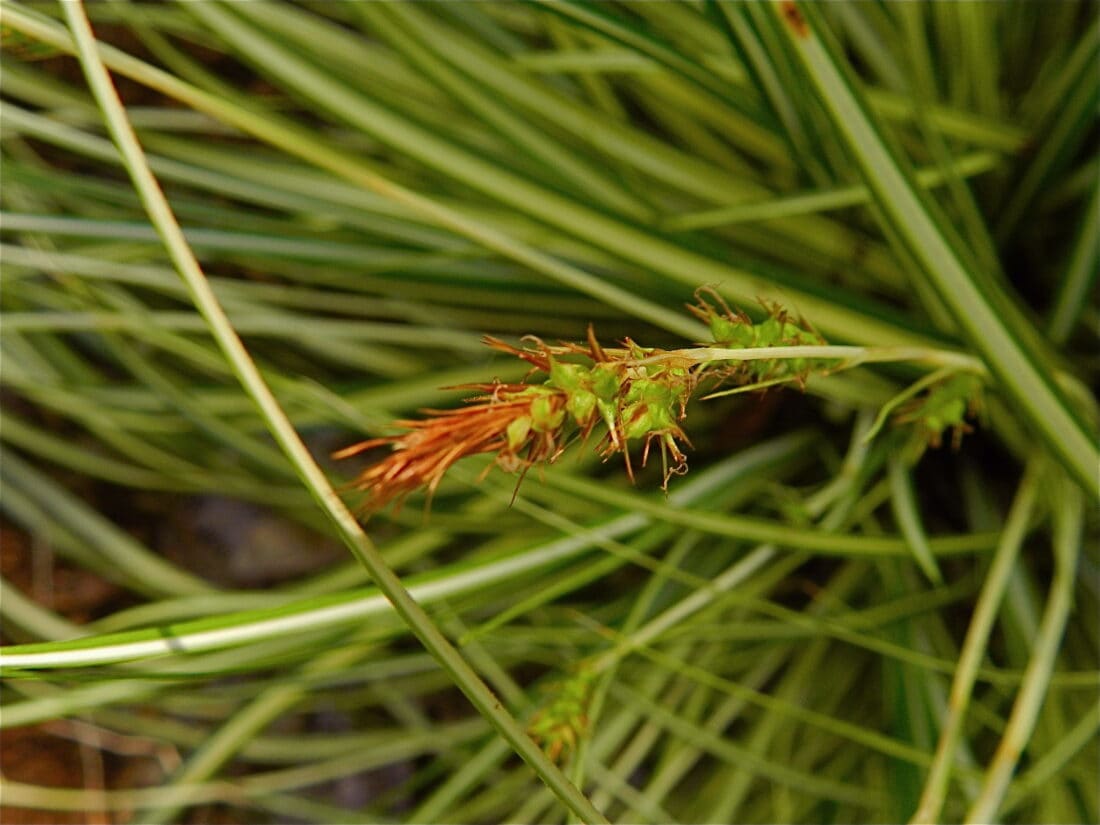
2) Carex ‘Evergold’
Carex ‘Evergold,’ a variegated sedge, is admired for its striking green and gold-striped leaves, adding color contrast to garden landscapes. This ornamental grass thrives in various conditions, making it a versatile and low-maintenance choice for garden design.
Shady Loving Grass-like Plant Alternatives:
we could suggest for the grassy look of Carex ‘Evergold’ are Carex pensylvanica – a native shade grass that is solidly green (and not a great contrast to the adjacent turf) and Mondo grass (opiopogon japonicus) which is only marginally hardy (down to zone 7) but may work in this spot since it is in the city and quite protected. We would have to experiment with it first.
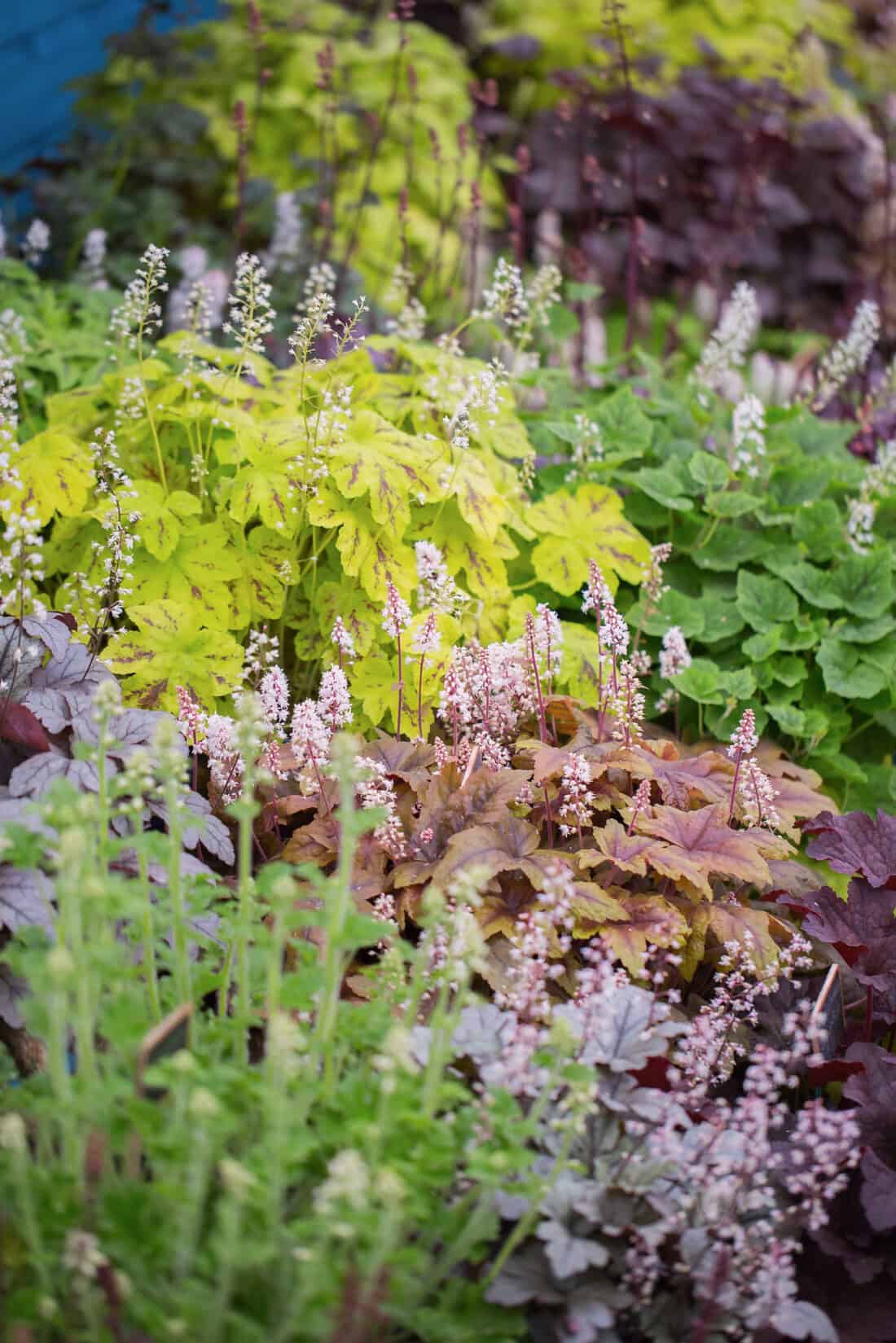
Shorter leafy plants
1) Heuchera varieities
Heuchera, commonly known as Coral Bells, is prized for its vibrant foliage and delicate bell-shaped tiny white flowers (I particularly like Heuchera Americana – other varieties have flowers in shades of pink and red).
These versatile perennials come in various colors, adding a burst of color to gardens. Heuchera is a low-maintenance plant suitable for a range of garden styles, from borders to containers.
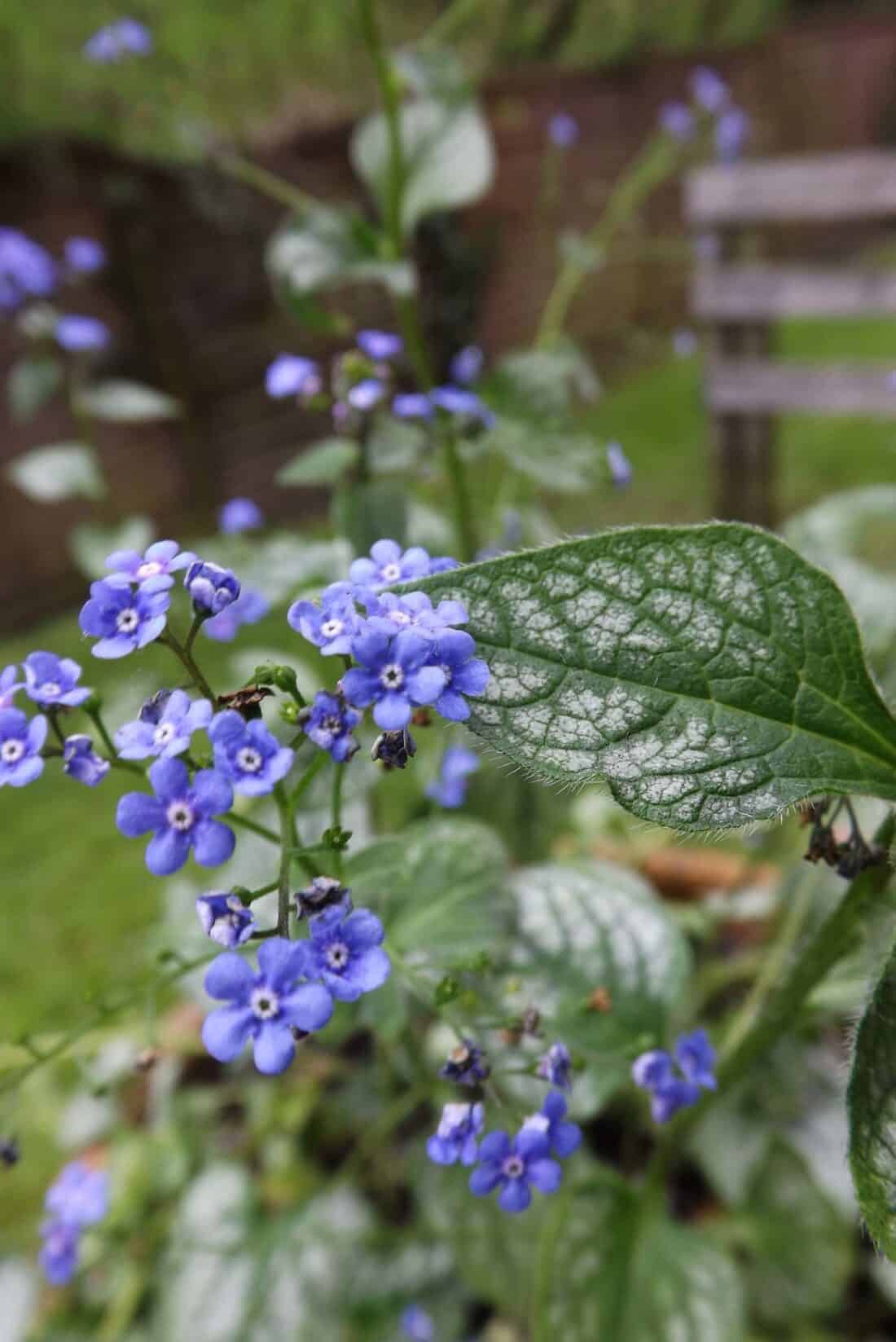
2) Brunnera ‘jack frost’
Brunnera ‘Jack Frost’ is celebrated for its striking silver foliage with intricate green veining and its profusion of tiny blue flowers that emerge in the spring. This shade-loving perennial provides a unique visual contrast in gardens. ‘Jack Frost’ is a low-maintenance plant and a popular choice for adding elegance to shaded areas.
Alternatives to the Brunnera and leafy shade plants
Bergenia, commonly known as Elephant’s Ears, which is appreciated for its large, leathery leaves and early spring blooms – or – Lamium, known as Dead Nettle, features colorful foliage and small, tubular flowers, making it a ground cover with decorative appeal.
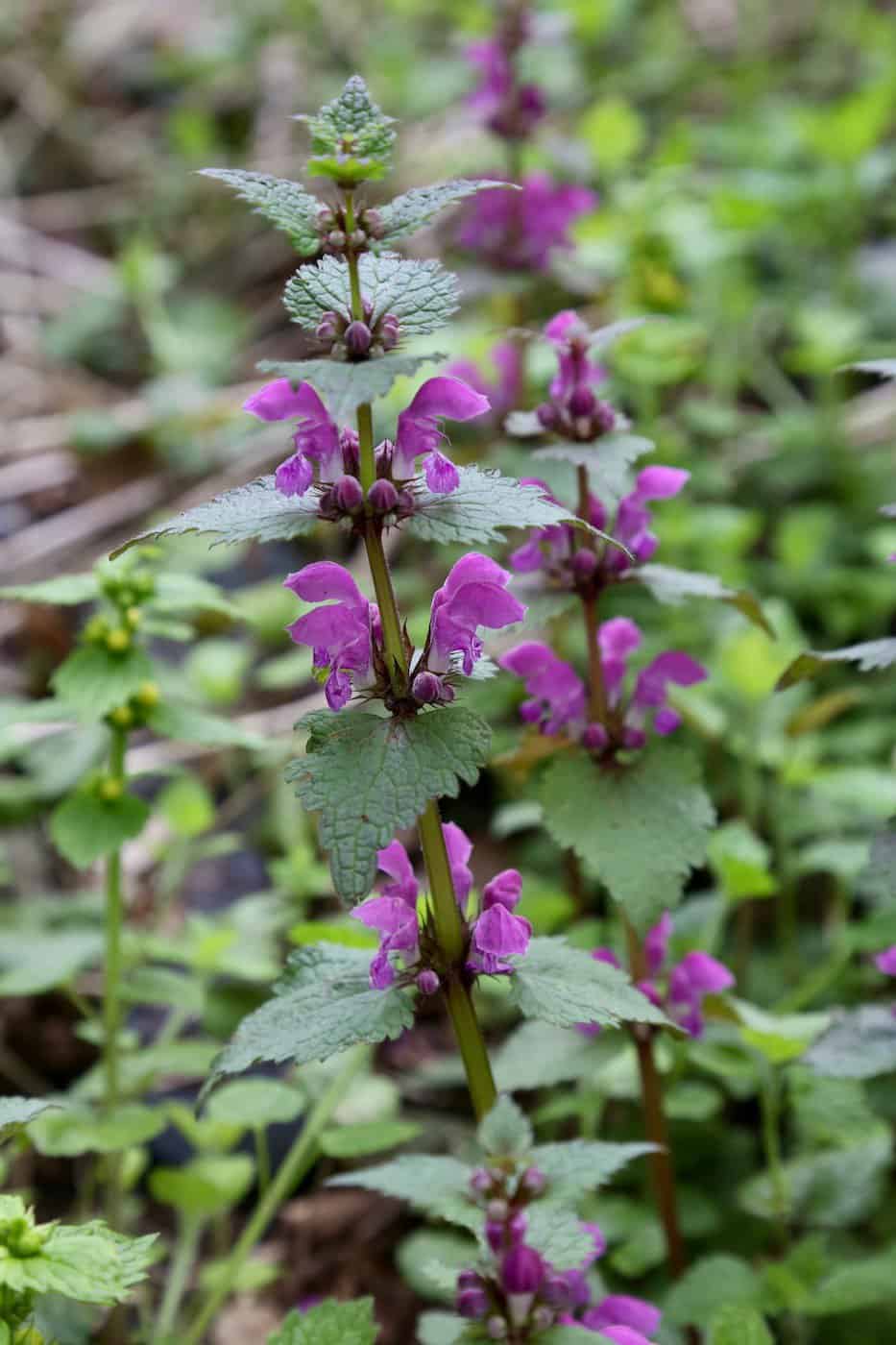
Berginia leaves can sometimes look a little ratty—particularly in a high-traffic area—and the Lamium can be aggressive, so they aren’t our first choices for this garden.
Epimedium, or Barrenwort, is admired for its delicate, heart-shaped leaves and dainty springtime flowers. This perennial is a low-maintenance, shade-loving plant, suitable for adding an understated charm to garden settings, but we did not choose it for this application because it is a bit more expensive and we think too dainty for this location.
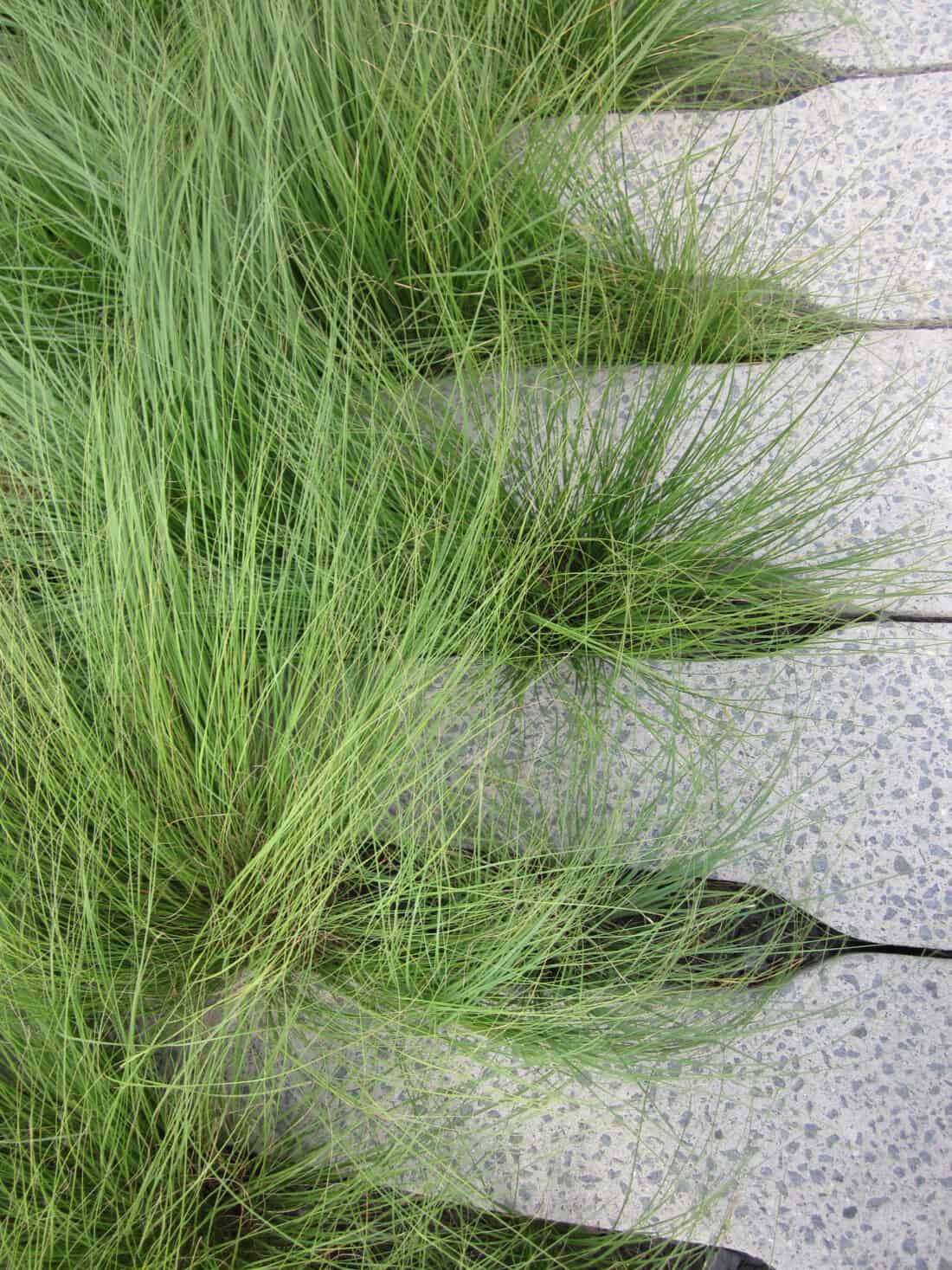
The beds are surrounded by turf, which can sometimes make other grassy groundcovers difficult to use. I find that it is best to plant sedges and ornamental grasses away from the bed edges, leaving other plants like ajuga, tiarella or wild blue phlox to define the barrier between the planted area and the lawn beyond.
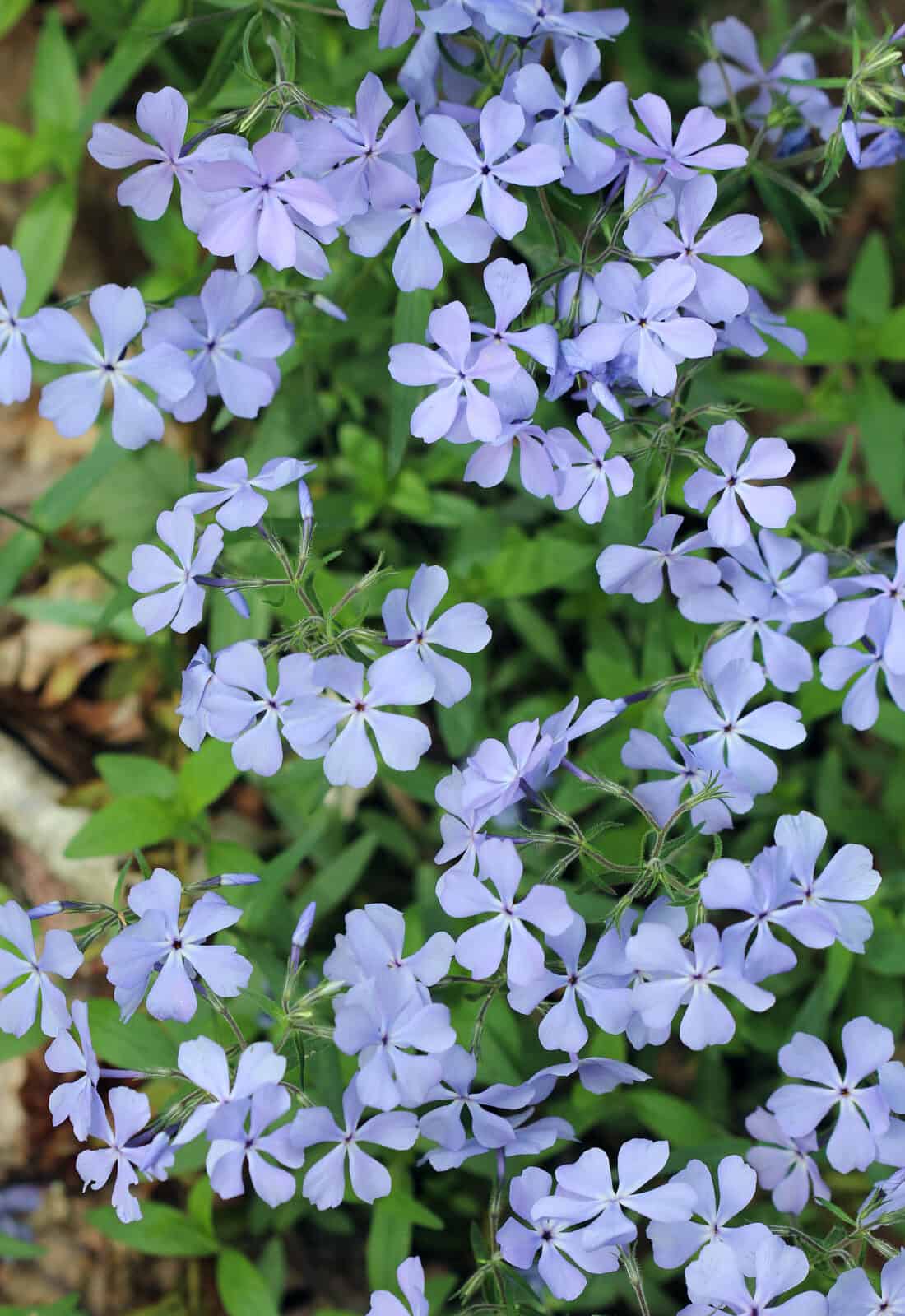
Wild Blue Phlox
Phlox divaricate by Philip Bouchard. Groundcovers for shade also include periwinkle (Vinca minor), hosta (Hosta spp.), and coral bells (Heuchera spp.). These low-growing plants thrive in shady areas, providing a lush carpet of foliage while suppressing weeds. They are easy to care for and can add beauty and interest to any shaded garden.
Tiarella
Tiarella wherryi. – Tim Waters. This shade tolerant ground cover thrives in the dark corners of the garden, providing a lush and green carpet under the trees.
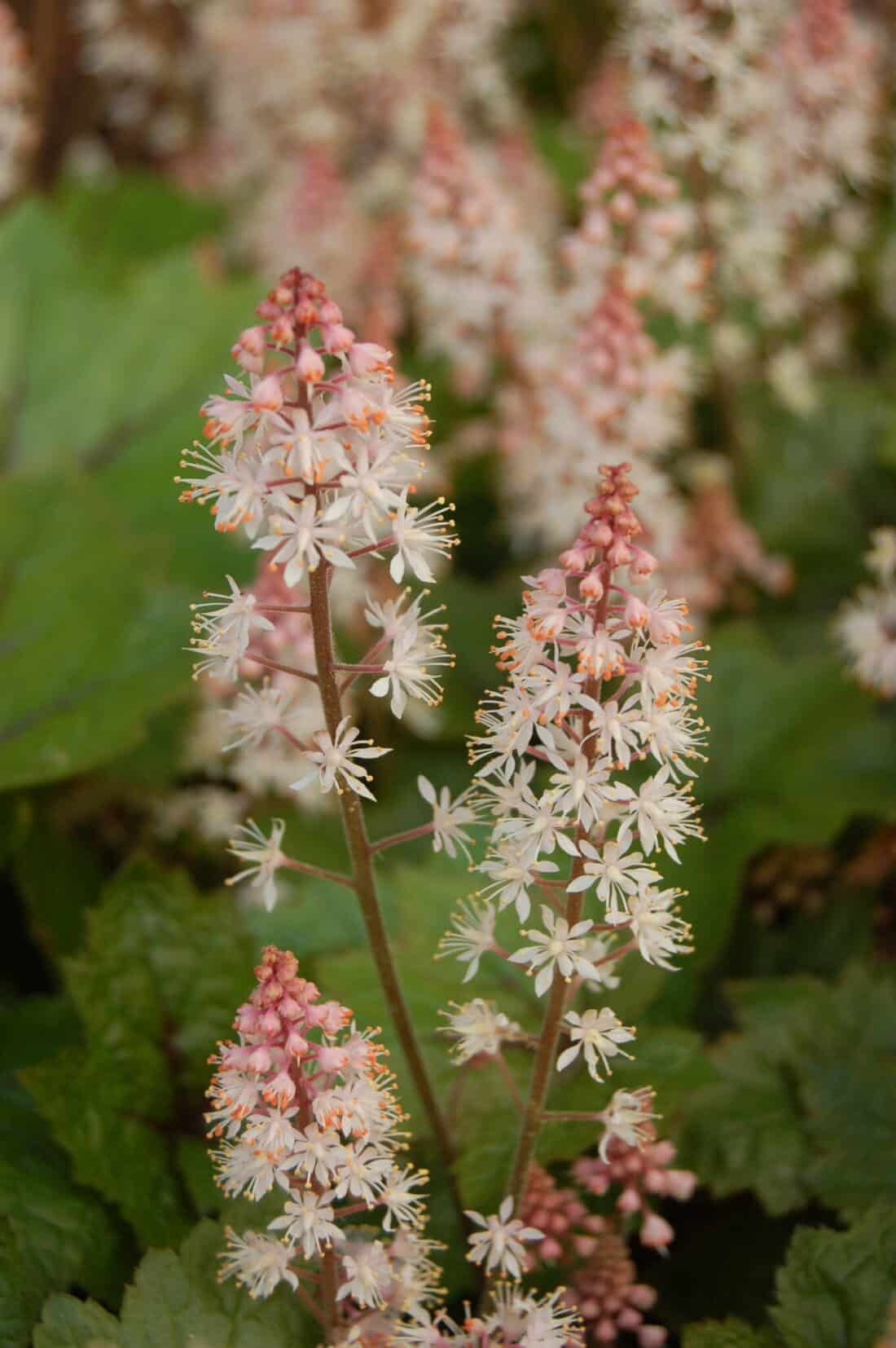
Colorful and flowering leafy plants
While heuchera and brunnera do have blooms – they are tiny. We want to add more eye-catching color to this mix – something that could be notable as cars pass by, and for that, we need plants with bigger, more showy flowers.
1) Woodland phlox, Phlox divaricata
Woodland phlox are cherished for their fragrant, lavender-blue blossoms that illuminate shaded areas in early spring. This native perennial offers a low-maintenance and attractive ground cover
2) Tiarella
Tiarella, also known as Foamflower, features dainty, foam-like flower spikes (in shades of pink or white) and attractive foliage, making it a captivating ground cover for shaded gardens. This elegant perennial is a low-maintenance tough choice that will bring interest not only when it blooms but throughout the season with its interesting foliage.
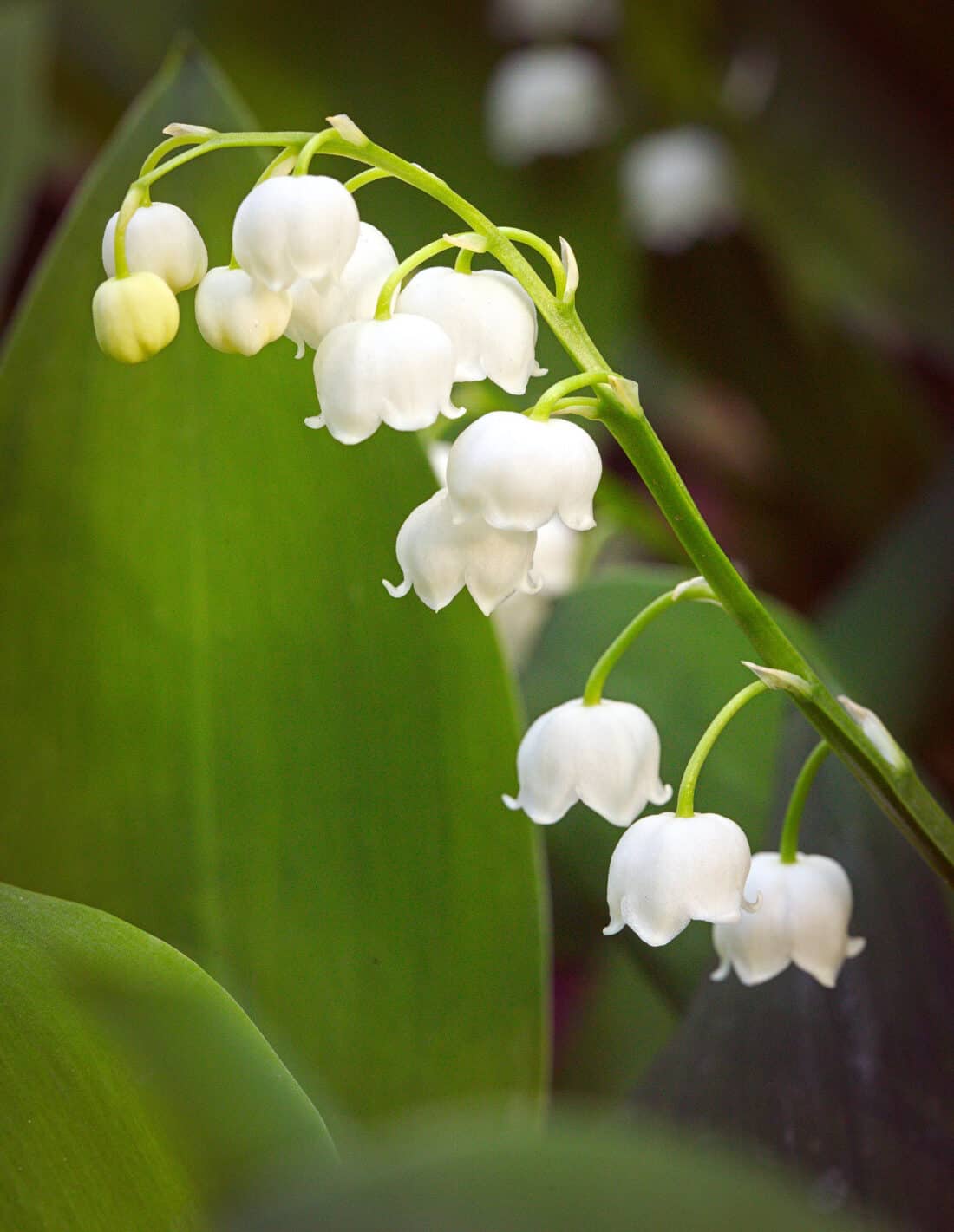
Spring Bulbs
Spring Bulbs will be underplanted throughout these beds. They will emerge, bloom, and recede before the perennials are visible, and their dying foliage will be obscured as they fill in through the growing season. We will especially focus bulbs around the existing tree roots. We will choose daffodils (Their yellow flowers are easily seen by passing drivers).
Grape hyacinths, crocus, (And other stinzenplanten style bulbs) for this setting so that we can ensure there is a progression of color and blooms in the late winter and early spring, but also, as the garden matures, we can enjoy the bulbs naturalizing and
The simple low-maintenance ground cover for shade option
Finally, the client asked for a simple ground cover option, suggesting ivy, pachysandra, and even grass. We don’t love any of these options. English ivy (hedera helix) tends to be a rat’s paradise. Pachysandra terminals (common name—Japanese spurge) are also not favorites. They can be thin, and this lack of foliar density means they often fail to look as good as you might hope. Both of these options are just boring and offer no ecosystem resources.
Other alternatives we considered that would thrive here (but that we didn’t choose them because they aren’t stylistically what we are trying to achieve with this garden) are Sweet woodruff (galium ordoratum), vinca minor (common periwinkle), lily of the valley, or other native ground covers that would create a dense mat (like ferns).
All of these are still in consideration for a more simple and less showy garden – if that is what the client decides to do. Many of these will provide a healthy green cover. They will suppress weeds and look tidy while also not requiring mowing or other regular maintenance.
Ivy is often a strong contender for shade ground cover, but I’m not a fan, and I never recommend it. Ivy is a shade-tolerant ground cover, but it‘s an invitation for rats and rodents. (Especially in urban areas and many parts of the country). Hedera helix (English Ivy) is invasive (in many parts of the country) and a complete PITB to get rid of. It quickly takes over and suffocates everything around it (including your house). Its sap is toxic, and frankly, I don’t think it is even attractive to look at. (Is it me, or is it always dusty and tired – and maybe even fake).
I like your colour combinations a lot. A nice replacement for your annual fall plantings would be the perennial white woods aster (Aster divaricatus). I use this a lot as it blooms when most other things are fading away and tolerates deep shade (you often find it growing in the woods). It has nearly black stems with 3/4″ white star like flowers. I think it would contrast nicely with some of the other plants that you are proposing. It does tend to get a bit leggy and I cut them back to 12″ in early summer.
Oh — I like the aster Idea…I will have to check and see what it looks like through the season…but white in the shade is always a fav. for me.
Those photos look lovely together.
Epimedium may be a bit sparse; around here zone 7 it doesn’t seem to fill in well.
You might try heuchera for color in shade – see
http://www.terranovanurseries.com/r/pages/plant-categories/heuchera.php
Mine have been indestructible. They came back fine after the huge DC snowstorm, and also after my mother “cleaned” them up one year, leaving little bare stems.
You know — I think you have a good point with the epimedium….I am thinking that Heuchera marmalade, or caramel, (or one of the really other orangy colored ones) would be a great addition!
Love your ideas. A good ground cover/ long bloomer with consistent look include any of the hardy geranium (Biokovo, ‘Katherine Adele’, Jolly Bee)
Also, what about bearberry (arc. uva ursi) as substitution for the clients ivy/pachy interest.
If conditions allow (moist garden soil) Id go for a sweep of several of the hakone grass varieties (Benekaze’ has reddish coloring).
Here are a few of my favorites for shade – phlox stolinifera which becomes a dense cover, waldstenia ternata which is very reliable, carex morowii ‘Ice dance” which is almost green year round in my next of the woods, ferns, tiarella which is a nice native, heuchera villosa which is a native and very durable….the other cultivars can wimp out in a tough spot like the one you are describing and all kinds of hostas which are the true shade workhorses – June, Sagae…I like the variegated ones.